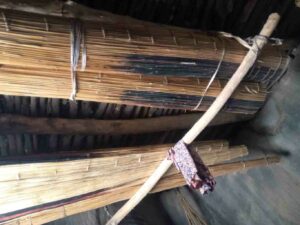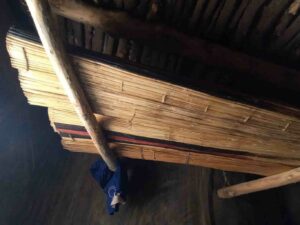Joseph Aduedem
KISUTA (TABOOS): THEIR ORIGINS AND SIGNIFICANCE AMONG THE BULSA
 INTRODUCTION
INTRODUCTION
I made a claim in (Aduedem 2018: 6) that, ‘“…every compound is a law to itself…” … [As such] it may not be wrong saying that every Bulsa household has its own law, for they are governed more by taboos (kisuta in Buli, singular: kisuk) than by societal laws.’ From a simple analysis of this claim, one would appreciate the fact that kisuta are part of the social structure in terms of guiding the behaviour and conduct of the Bulsa as a people. While admitting the differences in what is a kisuk among various families, this paper seeks to bring out the origin and significance of these kisuta in Bulsa society.
As an attempt to explain what kisuk is, I agree with Kröger on the simple explanation that kisuk is a “forbidden action, food or thing” (Kröger 1992: 132). Thus, kisuk simply means forbidden, one would only add what this ‘forbidden’ is connected to. So, one can talk of actions that can be forbidden, foods that can be forbidden, words that are forbidden, and so on. This leads to the various kinds of taboos (kisuta). There are kisuta in relation to totems, kisuta in relation to disease treatment, kisuta connected with special moments such as funerals, etc. All these are treated one after the other below.
TOTEMS (KISUK JAAB)
It might not be an exaggeration saying that every household of Buluk has something they taboo. This ranges from pythons, monkeys, crocodiles, hippopotamus, monitor lizard, etc. Upon asking why people taboo certain animals, one of two reasons are always given: either the animal once helped one of their ancestors and he vowed that he and his descendants would never kill or eat that animal. Or the ancestor had a bad encounter with the animal and vowed the same way. For instance, some people have it that one of their ancestors was ever helped by a crocodile to cross to the opposite side of a river and as a sign of eternal gratitude for that act, such an ancestor forbade all descendants of his killing and eating crocodile. In another instance, some people might even be having a god of that animal in the house that they sacrifice to. Families that have gods of such animals as that of crocodile, python, etc. certainly cannot eat that animal again. And then in situations where an ancestor had a bad encounter with a certain animal, this is enough reason to decree that no one from his lineage eats that animal. A clear example is why I am not supposed to eat python. Accordingly, one of our forefathers had a bush farm and he was rearing fowls there. On one unfaithful day, he went to the farm only to notice that his birds had been eaten up. With a critical analysis of the scene and thorough searching, he saw a hole that he suspected it was that of a python. He then gathered some dry grass and sticks, kept them in the hole and set fire to them. The fire and smoke heated up the hole to the extent that the python busted, forcefully opening the grounds and the whole thing resulted into the death of our ancestor. But before he died, he decreed that wa ngaang biik ale waab kpiemua, ‘no descent of his should have anything to do with python again’ – we should not eat python again.
Another reason people give for not eating certain animals is linked to the belief in life after death. Thus, some people believe that members of their lineage or clans transform into certain animals after death. So, eating such animals is simply eating your own relatives. It is said that this is partly the reason why people from Biuk do not eat crocodile.
KISUTA IN RELATION TO THE TREATMENT OF DISEASES
One other area that restricts people in terms of feeding is treatment of diseases. There are a lot of local medicines that taboo certain foods and meats and if one happens to be treated, those things become a taboo for the patient. A lot of local medicines forbid ja-sobluk (literally black thing), but there is more to say about what is termed as black. While I may disappoint you on what they referred to as ja-sobluk, we can still get examples of them. These include chevon (buuklam), fowl/chicken (kpiaklam), mudfish (jum sobluk/jum goalik), and in some extreme cases, the early millet (naara), beans (tue), salt petre (kaam), etc. There may not be any scientific explanation about how these prevent the medicine from working as alcohol or milk counteracts the chemistry of antibiotics. However, it would not be wrong categorising these under things that impede the efficiency of the local medicines.
TABOOS AT FUNERALS

These are the ta-pila (ritual mats) distinguished from ordinary mats because of the fibre that is used to tie them to the stick. Usually, the tail side of these mats faces the entrance of the ancestral room (dalong).
Under this, it must be noted that a Bulsa funeral involves a lot of things in terms of actions, rituals, food items, etc. Most of these are therefore forbidden outside funeral celebrations. The following are some of the things reserved for funeral celebrations alone, and cannot therefore be part of the ordinary day life of the people. Though not in a particular order, the first is the positioning of a mat. The usual way of positioning a rolled-up mat is to lean it against a wall, with its broader side (head) on the ground. Now in the case of a funeral, the mat (referred to as ta-pili) “is placed in the courtyard (dabiak) in front of the ancestors’ room (dalong), … [with] its thinner end on the ground, a placement that is strictly forbidden for mats without a ritual context (Kröger 2016: 58). Moreover, after a death-case, these mats are placed on the sampok with their thinner end facing the entrance of the dalong and they are tied to the sampok-stick with fibres, while ordinary mats on a sampok face the entrance with their thick end (the “head”) and they are not tied (see photos).
Another practice that is forbidden is putting local ropes on one’s hand, wrist or waist in ordinary daily life. This is because during a funeral celebration, fibre bands (boonsa, singular; boom) are tied to the left wrists of male relatives (Kröger 2017:p.103). Also, untwisted fibre (bok) or strings (miik) depending on the family/section of Buluk, is used to tie around a widow’s waist, chest and head. The untwisted fibre or strings identify her as such and also emphasize her still-close connection to the dead spouse and therefore, they should not be removed until the widow’s remarriage (Kröger 2017: 99).

Arrangement of ordinary mats on the sanpok. The head of the ordinary mat faces the entrance of the room, and without fibre they are held firmly on the stick.
One other thing connected with funerals is the kinds of food that is prepared. While some of them are not tabooed outside of funeral celebrations, the kpaam tue (literally oiled beans – thus, Bambara groundnuts and beans cooked together and eaten with plenty of shea butter in it) prepared on the Kpaata Dai (Aduedem 2019). The kamisa (cakes made from beans) are also prepared during the Juka ritual of funeral celebrations. Even though kuosa (which are almost like kamisa) are prepared and sold in the market, no family prepares those cakes for domestic use like maasa made from millet. So, because the kpaam tue and the kamisa are directly associated with funeral rituals, it is forbidden to prepare them for ordinary daily use.
Shaving the head is another area that comes with taboos because of its connection with funeral rites. The first thing is shaving in the night. On the Nyaata Soka Dai, usually the second day of the Juka rites, the widow is shaved outside the house in the night by a widower before the ritual bathing (juom soka) (Aduedem 2020: 55). Then again, one week after the funeral rites are over, the same man comes to shave the widow again and she prepares suma (Bambara groundnuts) and T.Z and thanks the man by serving him these food items. Because of this shaving in the night and the thanking of the man after the funeral rites, it is a taboo to shave somebody in the night in Buluk. It is equally a taboo to thank someone after the person has shaved you in a pure Buluk setting.
Still on funerals, it is a taboo to greet before announcing a funeral in Buluk. Thus, be it a fresh funeral or an old one and they are announcing to perform the final funeral rites, upon arrival at a house, you simply indicate that Ku ka puusa (meaning there is no greetings). Whatever the reasons might be, not greeting indicates urgency, and also a preparatory stage for giving sad news. This explains why it is not only before announcing funerals that we do not greet but also when you go for soothsaying.
KISUTA IN RELATION TO ETHICAL AND PRACTICAL CONCERNS
The taboos under this do not have ritual implications but they ensure good behaviour and safety of the individual and the society. An example for this is the taboo of not whistling in the night or in the bush. This is tabooed because there are snakes that are believed to be whistling and are attracted by whistling, too. So, when someone is whistling in the night or bush, you are simply inviting snake attacks upon yourself. This has nothing to do with ritual but the safety of the individual concern.
Another example for this is insults that involve describing some parts of the body. Again, almost every house taboos certain insults describing one part of the body or the other, such as your long ears (tue wogila), big eyes balls (nin kpita), big nose (nyue fuora), black skin (ja-sobluk), etc. Examining these insults closely, at times the eldest person (landlord, yeri nyono of the house or even the whole lineage) may be found possessing one of these defects. So, to insult a child of that family by that feature is in effect an insult to the whole family. I remember one house that we were tabooed from insulting any child from that house with reference to the ears. And the explanation was actually their great grandfather had very large pinnae.
SIGNIFICANCE OF TABOOS AND THEIR CONTEMPORARY STANDPOINT
The above has given us reasons to claim that the significance of taboos cannot go unnoticed. The first to talk about is the aspect of gratitude with respect to totems. It is seen from the above that some ancestors were helped by certain animals and as a sign of gratitude, they forbade any descendant of theirs from eating such a creature. What this implies is that a descendant of such an ancestor, regardless of his religious affiliation, may still hold high that eternal gratitude towards such an animal and he would not be considered an uncivilised individual. Besides, it could be a way of preserving certain species of animals in our society.
The second significance concerns things tabooed as a result of treatment from illnesses. Well, there might not be scientific reasons as to why and how certain food items are not eaten when going through some treatments, but it underscores the idea of drug counteraction in the modern-day sense. In other words, there are principles governing various sectors of human life and we should appreciate these forbidden foods in times of treatment as part of the principles in the herbal sector.
Another aspect is that the taboos serve to distinguish the ordinary from the non-ordinary. In other words, they are there as signs communicating something to people because they are self-explanatory. For instance, once you see somebody with ropes tied on his wrist, immediately you should know that such a person is mourning a close relative. Again, seeing calabashes in front of the entrance to the kraal means someone has just died in that house without even being told. The taboo of not putting ropes on the hand or placing calabashes by the entrance to the main entrance (except in funeral context ) is to avoid giving people wrong messages. This has nothing to do with rituals, it has to do with silently communicating messages to onlookers.
CONCLUSION
As we come to the conclusion of this paper, setting aside certain foods, actions and words as forbidden is a reality in Buluk, and the intentions for this vary depending on the circumstances and the instances. Be that as it may, every group, organisation, institution or society requires putting in place certain principles in order to maintain right conduct of its subjects, to sustain their identity and to ensure peace and security. That the Bulsa as a tribe are governed by kisuta is then, not out of place. There may not be scientific explanations for their “choice” of taboos, but all the same, the reason why they taboo certain foods, actions and words was borne out of their living experience of reality. Therefore, while I do not entirely go in for the idea of having taboos, I equally do not dismiss their significance in the sense of them being the principles governing the way of life of the people of Buluk.
REFERENCES
Aduedem, Joseph, “Builsa Funeral Rites: Are Builsa Christians (Catholics) Supposed To Perform?” [Unpublished work, 2019].
Aduedem, Joseph, “The Builsa Ghost: A Real Creature Or A Mythical Creature?”, Memoir, St Victor’s Major Seminary, Tamale, 2018.
Aduedem, Joseph, “Kuub Juka or Ngomsika, the Second Funeral Celebration”, Buluk. Journal of Bulsa Culture and Society, No. 13, 2020: 54-61.
Kröger, Franz. Buli―English Dictionary. Münster: Lit Verlag, 1992.
Kröger, Franz. “Religious and Rebellious Elements in Bulsa Funeral Rituals”, Buluk. Journal of Bulsa Culture and Society, No. 10, 2017: 97-113.
6. Kröger Franz, “Returning Home as a Dead Man, The Bulsa Ngarika-Burial”, Buluk. Journal of Bulsa Culture and Society, No 9, 2016: 53-61.
- Editorial
- Events
- Ghanatta Ayaric: Prof. S. Abanteriba awarded Medal of the Order of Australia (OAM)
- Franz Kröger House – Azantilow Senior High School, Sandema
- Franz Kröger: The Parliamentary and Presidential Elections 2020
- Franz Kröger, Robert Asekabta and Kennedy Azantilow : Electing New Bulsa Chiefs (2021-2022): Qualifications of a chief, elections in Fumbisi, Doninga, Kadema and Bachonsa
- Kennedy Azantilow and others: Feok Festival (and Associated Events) 2022
- Augustine Atano: Feok Festival 2020 (Review)
- Augustine Atano: The duration of the Feok Festival
- Augustine A. Atano: Feok Festival 2021 (Review)
- Kennedy Azantilow: Feok Festival 2022
- Franz Kröger: Who on Earth is Interested in the Bulsa?
- Franz Kröger: Obituaries
- Margaret Arnheim: Maaka in Buluk
- Martin Anbegwon Atuire: Bleeding Palimsests: Heritage Tourism…
- Kwesi Amoak: Review of Dr. Caesar Atuire’s “Philosophical Underspinnings of an African Legal System
- Joseph Aduedem: A Stranger in Her Own Land – The Position of Women in Bulsa Society
- Joseph Aduedem: Kisuta (taboos): Their Origins and Significance among the Bulsa
- Joseph Aduedem: Abunoruk maari Asuom / Abunoruk helped Asuom
- Joseph Aduedem: Yog Wiik
- Franz Kröger: The First Picture of an African Woman
- Franz Kröger: Recent Bulsa Publications
- Commentaries in the Internet Edition of Buluk
- Abdul-Rauf Akan-mwanatechaab: Brothers in Skirt
- John Agandin: The Fires Eat the Land at Home
- Bulsa Cuisine
- Ghanatta Ayaric: The New Masim Rice-Mill in Fumbisi